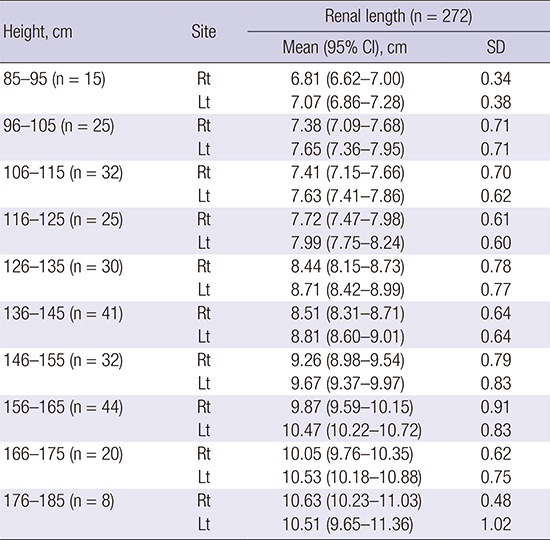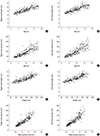1. Kim BW, Song MK, Chung S, Kim KS. Evaluation of kidney size in children: a pilot study of renal length as a surrogate of organ growth. Korean J Pediatr. 2012; 55:54–57.
2. Lee MJ, Son MK, Kwak BO, Park HW, Chung S, Kim KS. Kidney size estimation in Korean children with Technesium-99m dimercaptosuccinic acid scintigraphy. Korean J Pediatr. 2014; 57:41–45.
3. Kim JH, Kim MJ, Lim SH, Kim J, Lee MJ. Length and volume of morphologically normal kidneys in Korean children: ultrasound measurement and estimation using body size. Korean J Radiol. 2013; 14:677–682.
4. Zerin JM, Blane CE. Sonographic assessment of renal length in children: a reappraisal. Pediatr Radiol. 1994; 24:101–106.
5. Kim IO, Cheon JE, Lee YS, Lee SW, Kim OH, Kim JH, Kim HD, Sim JS. Kidney length in normal Korean children. J Korean Soc Ultrasound Med. 2010; 29:181–188.
6. Jorulf H, Nordmark J, Jonsson A. Kidney size in infants and children assessed by area measurement. Acta Radiol Diagn (Stockh). 1978; 19:154–162.
7. Dinkel E, Ertel M, Dittrich M, Peters H, Berres M, Schulte-Wissermann H. Kidney size in childhood. Sonographical growth charts for kidney length and volume. Pediatr Radiol. 1985; 15:38–43.
8. Shin HS, Chung BH, Lee SE, Kim WJ, Ha HI, Yang CW. Measurement of kidney volume with multi-detector computed tomography scanning in young Korean. Yonsei Med J. 2009; 50:262–265.
9. Jones TB, Riddick LR, Harpen MD, Dubuisson RL, Samuels D. Ultrasonographic determination of renal mass and renal volume. J Ultrasound Med. 1983; 2:151–154.
10. Schlesinger AE, Hernandez RJ, Zerin JM, Marks TI, Kelsch RC. Interobserver and intraobserver variations in sonographic renal length measurements in children. AJR Am J Roentgenol. 1991; 156:1029–1032.
11. Eze CU, Eze CU, Marchie TT, Ohagwu CC, Ochie K. Observer variability in sonographic measurement of kidney sizes among children in Benin-City, Nigeria. West Indian Med J. 2013; 62:817–824.
12. Moon JS, Lee SY, Nam CM, Choi JM, Choe BK, Seo JW, Oh K, Jang MJ, Hwang SS, Yoo MH, et al. 2007 Korean National Growth Charts: review of developmental process and an outlook. Korean J Pediatr. 2008; 51:1–25.
13. Du Bois D, Du Bois EF. A formula to estimate the approximate surface area if height and weight be known. 1916. Nutrition. 1989; 5:303–311.
14. Breau RH, Clark E, Bruner B, Cervini P, Atwell T, Knoll G, Leibovich BC. A simple method to estimate renal volume from computed tomography. Can Urol Assoc J. 2013; 7:189–192.
15. Haus F, Boissel O, Junter GA. Multiple regression modelling of mineral base oil biodegradability based on their physical properties and overall chemical composition. Chemosphere. 2003; 50:939–948.
16. Zhang Y, Ma H, Wang B, Qu W, Wali A, Zhou C. Relationships between the structure of wheat gluten and ACE inhibitory activity of hydrolysate: stepwise multiple linear regression analysis. J Sci Food Agric. 2016; 96:3313–3320.
17. Cao X, Zurakowski D, Diamond DA, Treves ST. Automatic measurement of renal volume in children using 99mTc dimercaptosuccinic acid SPECT: normal ranges with body weight. Clin Nucl Med. 2012; 37:356–361.
18. Frazer FL, Palmer LJ, Clarey A, Thonell S, Byrne GC. Relationship between renal volume and increased albumin excretion rates in children and adolescents with type 1 diabetes mellitus. J Pediatr Endocrinol Metab. 2001; 14:875–881.
19. Blane CE, Bookstein FL, DiPietro MA, Kelsch RC. Sonographic standards for normal infant kidney length. AJR Am J Roentgenol. 1985; 145:1289–1291.
20. Holloway H, Jones TB, Robinson AE, Harpen MD, Wiseman HJ. Sonographic determination of renal volumes in normal neonates. Pediatr Radiol. 1983; 13:212–214.
21. Kim KS, Park JH. Sonographic assessment of renal size in normal children. Korean J Nephrol. 1989; 8:384–389.
22. Loftus WK, Gent RJ, LeQuesne GW, Metreweli C. Renal length in Chinese children: sonographic measurement and comparison with western data. J Clin Ultrasound. 1998; 26:349–352.
23. Hederström E, Forsberg L. Kidney size in children assessed by ultrasonography and urography. Acta Radiol Diagn (Stockh). 1985; 26:85–91.
24. Buchholz NP, Abbas F, Biyabani SR, Afzal M, Javed Q, Rizvi I, Talati J. Ultrasonographic renal size in individuals without known renal disease. J Pak Med Assoc. 2000; 50:12–16.
25. Oh MS, Hwang G, Han S, Kang HS, Kim SH, Kim YD, Kang KS, Shin KS, Lee MS, Choi GM, et al. Sonographic growth charts for kidney length in normal Korean children: a prospective observational study. J Korean Med Sci. 2016; 31:1089–1093.
26. Scholbach T, Weitzel D. Body-surface-area related renal volume: a common normal range from birth to adulthood. Scientifica (Cairo). 2012; 2012:949164.
27. Ermanta HC, Martadiani ED, Poernomo W. Body surface area (BSA) as the predictor of renal parenchymal volume in healthy adult. Folia Medica Indones. 2004; 40:112–120.
28. Leung RS. Radiation protection of the child from diagnostic imaging. Curr Pediatr Rev. 2015; 11:235–242.










 PDF
PDF ePub
ePub Citation
Citation Print
Print





 XML Download
XML Download